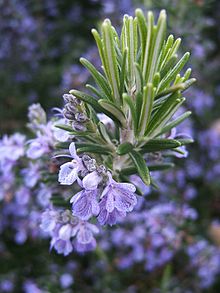Greek name and pronunciation:
Thendrolivano, δεντρολίβανο, pronounced then-droh-LEE-vah-no (hard th sound)
At the market:
Dried rosemary is usually packaged in disposable containers or sprinkle-pour bottles. Fresh bunches of rosemary may be available during its growing season, when the weather is warm. Rosemary does well in a kitchen herb garden.

Rosemary – Dentrolivano
Physical characteristics:
Rosemary is a member of the mint family, and is a woody evergreen shrub that usually grows to 18-24 inches tall. It has leathery leaves which are green (sunny side) and white (shady side). Trumpet-shaped blue-white flowers grow on spikes which extend from where leaves attach to the stem. There are at least 24 types of upright rosemary and another 12 types of creeping rosemary.
Usage:
Rosemary is one of those utilitarian herbs that complement and enrich a variety of foods, either as an ingredient in the food or as an aroma for roasted meats. Rosemary is also used in marinades, salads, breads, cooked greens and soups.
Substitutes:
Try sage, savory, or thyme.
Origin, History, and Mythology:
Rosemary is grown in many temperate climates, from southern Europe and the Mediterranean to most areas of the U.S. and beyond. Several ancient civilizations used rosemary as both a medicine and cooking herb.
To Egyptians of antiquity, rosemary for good for both the living and the dead. The herb was buried with the pharaohs. Believed to have magical powers to banish evil spirits, it was burned in sick rooms as a disinfectant, and was used to ward off the plague.
Perhaps the earliest written record of man’s use of rosemary dates from the 5th millenium B.C.E., by Sumerians in cuneiform on stone tablets.
As a medicine, various preparations and extracts made from rosemary were used to treat stomach and abdominal pain, to soothe mouth ulcers and sore throats, to lessen the pains of arthritic joints, to promote healing of wounds and of eczema. Rosemary is called “the herb of remembrance.” Rosemary tea is said to act as a stimulant for study and concentration.
In certain cultures, it was/is customary for the bride to have a sprig of rosemary in her wreath or wedding bouquet. Perhaps rosemary is Cupid’s “herbal matchmaker,” as suggested by the lyrics of an ancient ballad: “Young men and maids do ready stand, With sweet rosemary in their hands.”

